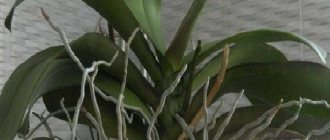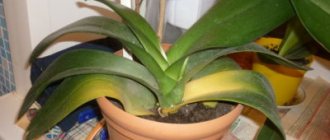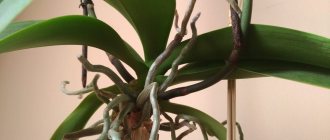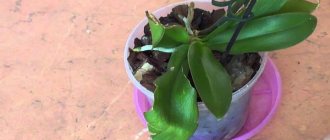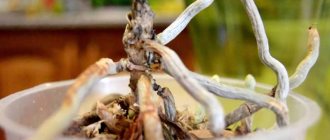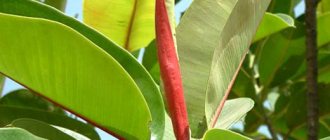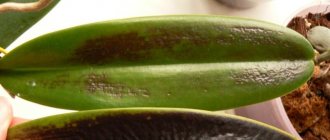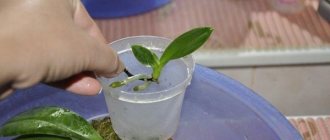Author of the article: Anna Vladimirovna | Updated: 02/23/2022
Waffle iron Kitfort KT-1611, yellow
1790 ₽ More details
Waffle iron Kitfort KT-1611, yellow
1790 ₽ More details
Tabletop stoves Kitfort
The luxuriously beautiful phalaenopsis orchid under natural conditions lives on the surface of other plants and receives nutrients through aerial roots. At home, she is deprived of such freedom in space. Its entire root system is placed in a pot. But it happens that not all roots want to live in any container. They crawl out of the pot and stick out in different directions. So what are these aerial roots of an orchid and why do they behave so strangely, upsetting their admirer? You can find out more about this in this article.
Disease or normal?
When you look at a flower with aerial roots scattered across the surface, you are immediately at a loss as to the reasons for this behavior. After all, after landing, it looked graceful and elegant, but now it looks like a predatory monster with protruding tentacles. Why does this happen in orchids?
There is no need to worry about returning the emerging roots back to the pot, much less cutting them off and letting them dry. For epiphytes, the presence of aerial roots is a natural state. Aerial roots are supporting structures that support the above-ground part of the plant. It is thanks to them that the flower receives a significant amount of moisture from the air and actively participates in the process of photosynthesis. Orchid roots are a good indicator of watering. When there is enough moisture, they have a bright green color; when there is a lack of liquid, they acquire a silver color.
To understand what is happening, it is necessary to understand the structure of the aerial root system. It is represented by elastic flat or cylindrical roots, covered with a dense spongy shell - velamen. Thanks to this coating, the plant’s roots well absorb and accumulate nutrients and moisture from the air. During the dry period, the shell layers (about 15 layers) perform a protective function for the root system, serving as a reservoir for moisture. They have a protective effect in case of mechanical damage.
If there are a significant number of aerial roots (more than three), the watering regime of the phalaenopsis should be monitored. Excessive oversaturation of the substrate with moisture can lead to abundant growth of roots and force them to crawl out, and subsequently contribute to their rotting.
The first reason is waterlogging.
If watering is abundant and a lot of moisture accumulates in the pot, the orchid begins to abundantly grow roots directed outward. In this case, their task is to increase the area of evaporation and remove excess liquid in order to prevent the onset of rotting.
Excessive humidification at low indoor temperatures is especially dangerous.
To stop the growth of aerial roots in this case, you need to reduce watering and place the flower pot in a warm, well-lit place. It should be borne in mind that the orchid does not tolerate direct sunlight.
Choosing the right filler for planting
The condition of the root system is an indicator of the health of the orchid. The bright green color of the roots indicates the stage of active growth of the plant, the pale green color demonstrates the dilapidation of the velomen. The plant's root system is constantly developing. But the absence of new bright green roots for several months requires paying attention to caring for the orchid.
An improperly prepared substrate for planting an orchid can promote the appearance of aerial roots . Phalaenopsis must be replanted only in special soil for orchids, which includes: the bark of coniferous trees (pine, spruce, larch, pine), sphagnum moss and charcoal in a ratio of 5:2:1, respectively. If the substrate is dense and has poor air exchange, the roots grow upward. Earthen soil is not recommended for planting, as this leads to rotting of the roots. In such cases, it is necessary to provide resuscitation to the plant. It is removed from the pot. Carefully remove from the previous substrate. Then the root system is thoroughly washed and inspected for rotten and dry parts. It is difficult to immediately distinguish living roots from dead ones, but when wet, active roots become green. The dead become black and soft to the touch. Trimming damaged and dried areas is carried out with a disinfected instrument (knife, blade). The cut areas are treated with charcoal powder and left to air dry. The plant is placed in a dry, warm place to dry completely. The rosette of leaves is wiped dry from moisture with a soft cloth to avoid further rotting. After these manipulations, the phalaenopsis is transplanted into a transparent plastic pot with new soil. The plant should not be watered for several days.
Ready-made mixtures for planting can be purchased at specialized garden centers or flower shops. It is recommended to purchase soil from natural ingredients. In addition to the classic composition (coniferous tree bark, moss, activated carbon), to improve the nutritional properties of the substrate, finely chopped fern root, pine cones, coconut fibers or chips, crushed coconut or walnut shells are added.
Features of transplantation
After the purchase
A plant should be replanted after purchase only if it dies. Otherwise, if the substrate is good, then there is no need to replant.
If the bark has collapsed, it is replanted under the following conditions:
- after flowering;
- after the plants have acclimatized in your apartment (about 2 weeks).
in spring
The best period for transplantation is spring, when daylight hours increase (late February-early March). The transplant technology is standard.
In a glass vase
Quite an unusual way of planting and cultivating orchids. The positive side of this is that the plant hardly needs to be watered. In the sense that with the correct selection and placement of substrate components, moisture from the bottom of the vase gradually rises up and reaches the roots. Under such conditions, the root system can reach relatively large sizes and resemble a beard.
Orchids in glass vases.
It should be understood that this method requires some experience and knowledge, the volume of which is worthy of a separate article and will not fit into a small paragraph.
Old orchid
Old plants are replanted in the same way as young or mature plants
The only caveat is that with a particularly large plant you need to be more careful than with small, young ones.
Old, well-cared for orchids usually have a bushy root beard that is easily damaged. You need to be careful with them. Otherwise, the transplantation technology is identical to specimens of other ages.
Darkening of the roots
The appearance of dark spots on the aerial and ground roots of phalaenopsis may indicate several reasons:
- the presence of a putrefactive process in the root system due to improper watering;
- the appearance of spots as a result of treating the roots with mineral fertilizers, as a result of which salt deposits appear on the roots;
- incorrect concentration of fertilizer dilution, which led to root burns.
Why did the aerial roots of our orchid darken, what should we do to restore and regenerate them?
Orchid Rescue
Some gardeners unknowingly bring their orchids to a deplorable state. But this flower has a huge thirst for life, and you need to fight for it to the end. Is it possible to save an orchid if the care was absolutely incorrect and even destructive? As a rule, there is always hope for salvation. Even if the roots have rotted from excessive watering and only a couple of aerial roots remain, you can try to save the plant.
To restore an orchid, dried leaves, roots and tendrils are trimmed.
The sequence of actions is as follows. You need to remove the bush from the flower pot, wash the root system, and remove rotten roots. At the base of the rosette there are dry scales from previously dried and fallen leaves. New root shoots are emerging under these scales - you need to make way for them. Carefully remove dry scales with your hands; do not use knives or scissors, so as not to injure the plant and accidentally cut off young shoots. The plant is ready to be planted in a new pot.
It will not be possible to save the only orchid whose center of growth—the crown of the plant’s rosette—is rotting. This can occur as a result of stagnation of water between the leaves at the growth point, as a result of which putrefactive processes begin. It is enough to be careful that no water gets into the outlet during watering, and if it does, simply drain it.
If it suddenly turns out that the moment was missed and the center of growth was nevertheless damaged, do not rush to get upset and throw away the orchid before it dries out. In this state, phalaenopsis can live for quite a long time and even produce a peduncle. And under favorable conditions of maintenance, a baby will definitely appear on the peduncle - nevertheless, the thirst for life of orchids is worthy of admiration.
Treatment
When the roots rot, the plant is removed from the substrate. The root system is treated and cleaned of putrefactive damage. The question often arises: is it possible to cut off almost all the roots due to rotting and save the plants? In cases where the roots have rotted completely and the plant is deprived of root nutrition, resuscitation measures are carried out to provide the flower with moisture and nutrients.
Two methods of arranging orchids are used: above water and in water. When installed above water, the lower part of the plant is immersed in a solution of succinic acid (4 tablets per 1 liter of water) every two days. Can be immersed in a vitamin solution (1 ampoule of vitamins B1, B6, B12 in 1 liter of water). With the water method, the lower part is immersed in water and foliar feeding is systematically carried out. New roots will begin to appear in 2-3 months. Transplantation into the ground is carried out when the roots are at least 5 cm long.
It is also possible for salts to be deposited on the roots when treated with mineral fertilizers. It must be taken into account that the presence of mineral salts is present not only in the fertilizer, but also in tap water. It is recommended to use only filtered soft water.
Burns to the root system when using high concentrations of fertilizers. To avoid such burns, it is advisable to water the plant abundantly 2-3 hours before applying fertilizing.
Unfortunately, root burn when using a high concentration of fertilizer, as well as the deposition of salts from hard water on the roots, cannot be treated.
Useful tips
When planting an orchid, a five-centimeter layer of drainage made of expanded clay , perlite or polystyrene foam balls is poured onto the bottom of the pot. A prepared soil mixture 5-6 cm high is laid on top, and an orchid is placed on it.
The roots are covered with substrate and the pot with the plant is lowered into a container of water for a few minutes. We hope that after reading our article it becomes clearer to you what to do with orchid roots that grow outward. If you have any questions, write them in the comments, we will try to answer!
